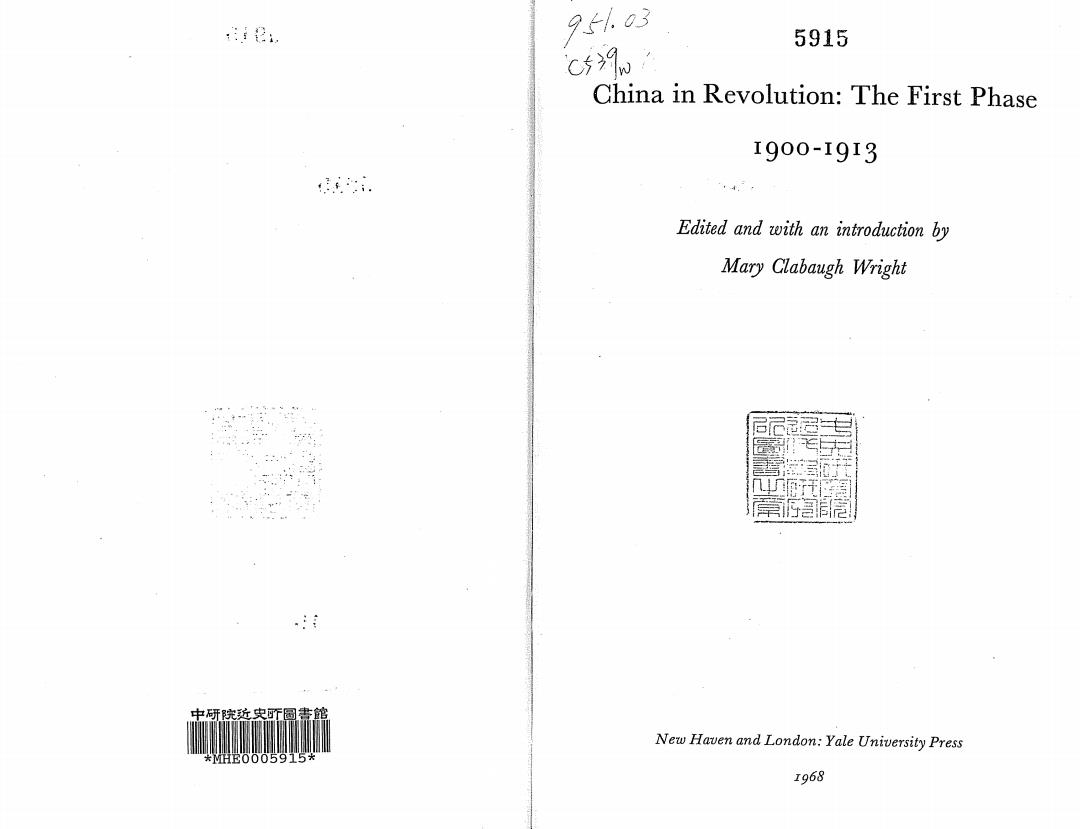
961.03 5915 C59’ China in Revolution:The First Phase I900-I9I3 Edited and with an introduction by Mary Clabaugh Wright ” 常恺 中研完行史四下 New Haven and London:Yale University Press 1968
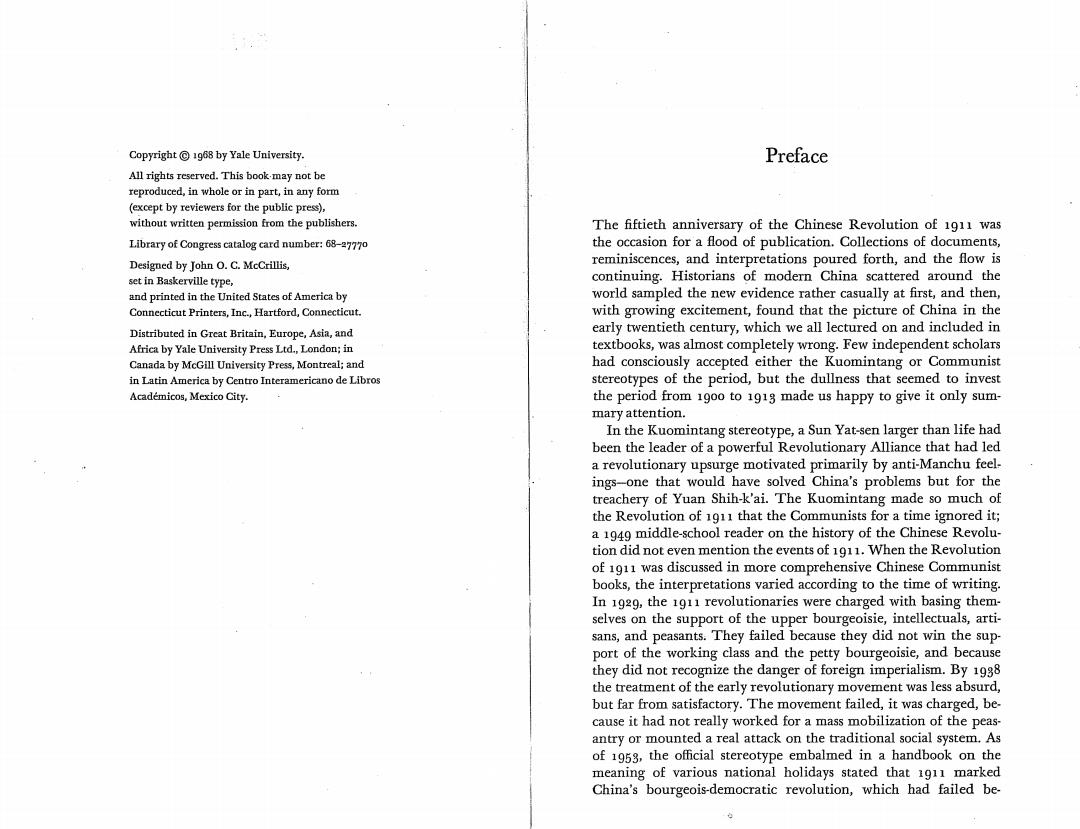
Copyright C 1968 by Yale University. Preface All rights reserved.This book may not be reproduced,in whole or in part,in any form (except by reviewers for the public press), without written permission from the publishers. The fiftieth anniversary of the Chinese Revolution of 1911 was Library of Congress catalog card number:68-27770 the occasion for a flood of publication.Collections of documents, Designed by John O.C.McCrillis, reminiscences,and interpretations poured forth,and the flow is set in Baskerville type, continuing.Historians of modern China scattered around the and printed in the United States of America by world sampled the new evidence rather casually at first,and then, Connecticut Printers,Inc.,Hartford,Connecticut. with growing excitement,found that the picture of China in the Distributed in Great Britain,Europe,Asia,and early twentieth century,which we all lectured on and included in Africa by Yale University Press Ltd.London:in textbooks,was almost completely wrong.Few independent scholars Canada by McGill University Press,Montreal;and had consciously accepted either the Kuomintang or Communist in Latin America by Centro Interamericano de Libros stereotypes of the period,but the dullness that seemed to invest Academicos,Mexico City. the period from 1goo to 1913 made us happy to give it only sum- mary attention. In the Kuomintang stereotype,a Sun Yat-sen larger than life had been the leader of a powerful Revolutionary Alliance that had led a revolutionary upsurge motivated primarily by anti-Manchu feel- ings-one that would have solved China's problems but for the treachery of Yuan Shih-k'ai.The Kuomintang made so much of the Revolution of 1911 that the Communists for a time ignored it; a 1949 middle-school reader on the history of the Chinese Revolu- tion did not even mention the events of 1911.When the Revolution of 1911 was discussed in more comprehensive Chinese Communist books,the interpretations varied according to the time of writing. In 1929,the 1911 revolutionaries were charged with basing them- selves on the support of the upper bourgeoisie,intellectuals,arti- sans,and peasants.They failed because they did not win the sup- port of the working class and the petty bourgeoisie,and because they did not recognize the danger of foreign imperialism.By 1938 the treatment of the early revolutionary movement was less absurd, but far from satisfactory.The movement failed,it was charged,be- cause it had not really worked for a mass mobilization of the peas. antry or mounted a real attack on the traditional social system.As of 1953,the official stereotype embalmed in a handbook on the meaning of various national holidays stated that 1911 marked China's bourgeois-democratic revolution,which had failed be-
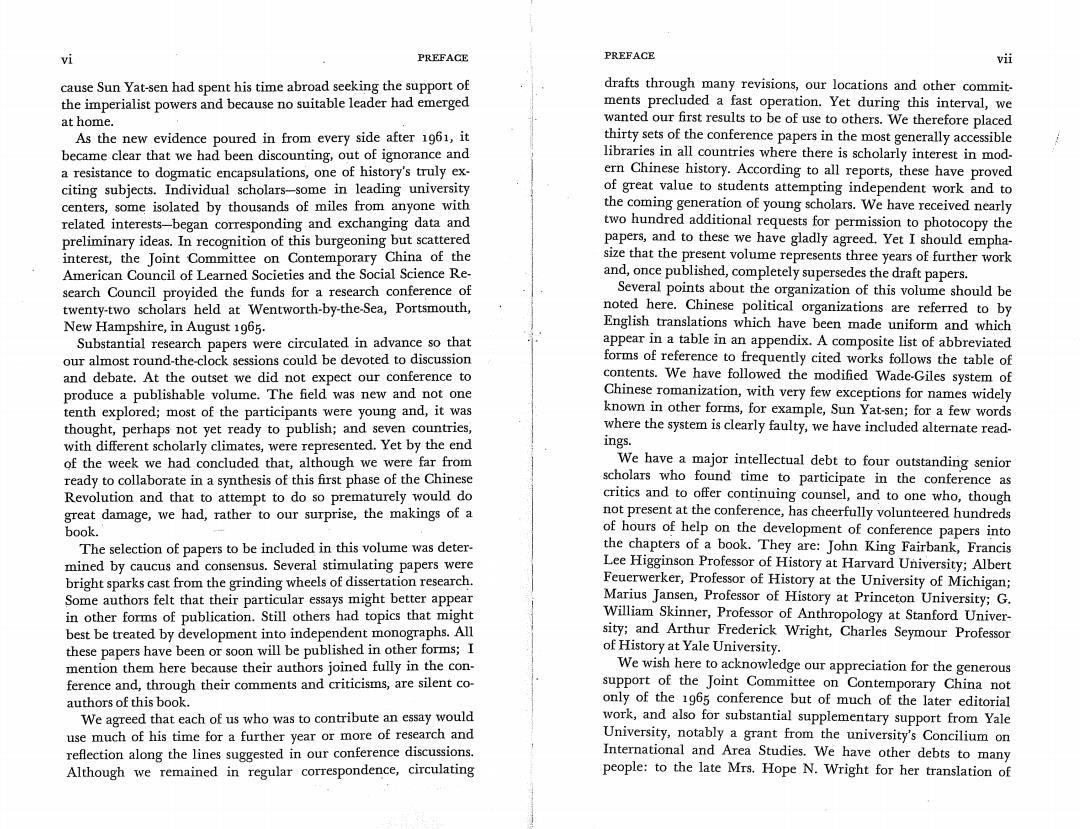
vi PREFACE PREFACE vii cause Sun Yat-sen had spent his time abroad seeking the support of drafts through many revisions,our locations and other commit- the imperialist powers and because no suitable leader had emerged ments precluded a fast operation.Yet during this interval,we at home. wanted our first results to be of use to others.We therefore placed As the new evidence poured in from every side after 1961,it thirty sets of the conference papers in the most generally accessible became clear that we had been discounting,out of ignorance and libraries in all countries where there is scholarly interest in mod- a resistance to dogmatic encapsulations,one of history's truly ex- ern Chinese history.According to all reports,these have proved citing subjects.Individual scholars-some in leading university of great value to students attempting independent work and to centers,some isolated by thousands of miles from anyone with the coming generation of young scholars.We have received nearly related interests-began corresponding and exchanging data and two hundred additional requests for permission to photocopy the preliminary ideas.In recognition of this burgeoning but scattered papers,and to these we have gladly agreed.Yet I should empha- interest,the Joint Committee on Contemporary China of the size that the present volume represents three years of further work American Council of Learned Societies and the Social Science Re- and,once published,completely supersedes the draft papers. search Council proyided the funds for a research conference of Several points about the organization of this volume should be twenty-two scholars held at Wentworth-by-the-Sea,Portsmouth, noted here.Chinese political organizations are referred to by New Hampshire,in August 1965. English translations which have been made uniform and which Substantial research papers were circulated in advance so that appear in a table in an appendix.A composite list of abbreviated our almost round-the-clock sessions could be devoted to discussion forms of reference to frequently cited works follows the table of and debate.At the outset we did not expect our conference to contents.We have followed the modified Wade-Giles system of produce a publishable volume.The field was new and not one Chinese romanization,with very few exceptions for names widely tenth explored;most of the participants were young and,it was known in other forms,for example,Sun Yat-sen;for a few words thought,perhaps not yet ready to publish;and seven countries, where the system is clearly faulty,we have included alternate read- with different scholarly climates,were represented.Yet by the end ings. of the week we had concluded that,although we were far from We have a major intellectual debt to four outstanding senior ready to collaborate in a synthesis of this first phase of the Chinese scholars who found time to participate in the conference as Revolution and that to attempt to do so prematurely would do critics and to offer continuing counsel,and to one who,though great damage,we had,rather to our surprise,the makings of a not present at the conference,has cheerfully volunteered hundreds book. of hours of help on the development of conference papers into The selection of papers to be included in this volume was deter- the chapters of a book.They are:John King Fairbank,Francis mined by caucus and consensus.Several stimulating papers were Lee Higginson Professor of History at Harvard University;Albert bright sparks cast from the grinding wheels of dissertation research. Feuerwerker,Professor of History at the University of Michigan; Some authors felt that their particular essays might better appear Marius Jansen,Professor of History at Princeton University;G. in other forms of publication.Still others had topics that might William Skinner,Professor of Anthropology at Stanford Univer- best be treated by development into independent monographs.All sity;and Arthur Frederick Wright,Charles Seymour Professor these papers have been or soon will be published in other forms;I of History at Yale University. mention them here because their authors joined fully in the con- We wish here to acknowledge our appreciation for the generous ference and,through their comments and criticisms,are silent co- support of the Joint Committee on Contemporary China not authors of this book. only of the 1965 conference but of much of the later editorial We agreed that each of us who was to contribute an essay would work,and also for substantial supplementary support from Yale use much of his time for a further year or more of research and University,notably a grant from the university's Concilium on reflection along the lines suggested in our conference discussions. International and Area Studies.We have other debts to many Although we remained in regular correspondence,circulating people:to the late Mrs.Hope N.Wright for her translation of
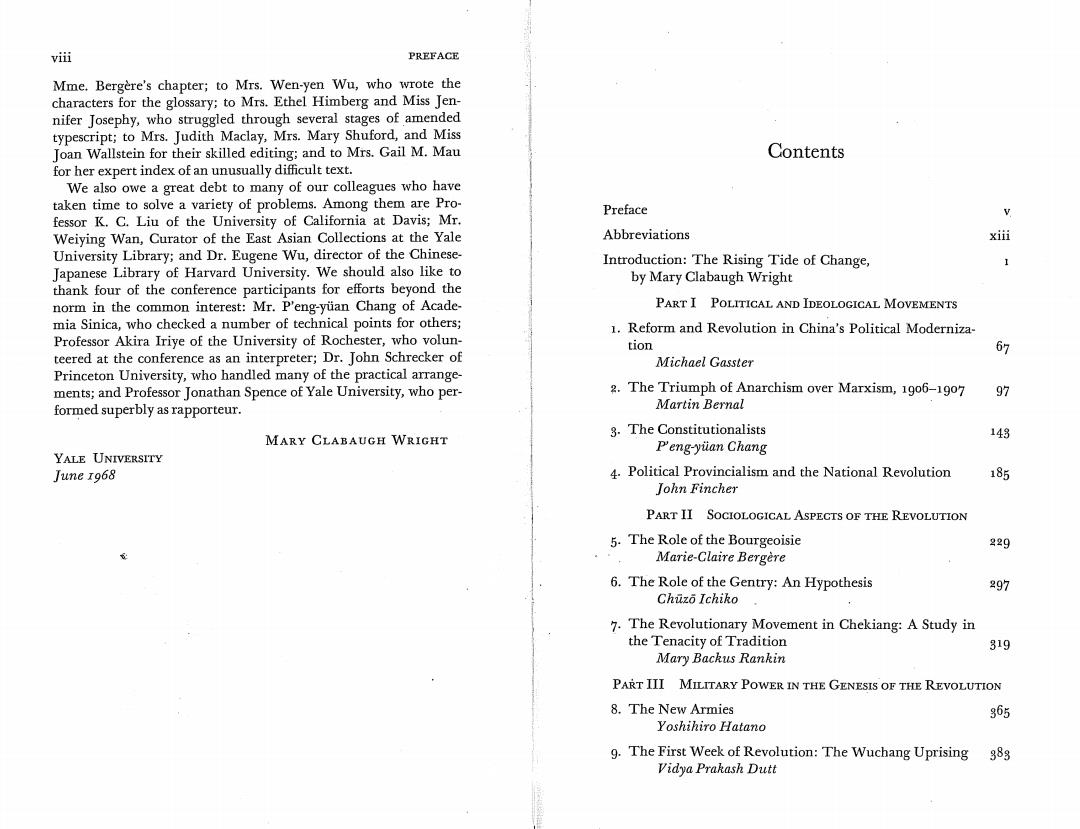
viii PREFACE Mme.Bergere's chapter;to Mrs.Wen-yen Wu,who wrote the characters for the glossary;to Mrs.Ethel Himberg and Miss Jen- nifer Josephy,who struggled through several stages of amended typescript;to Mrs.Judith Maclay,Mrs.Mary Shuford,and Miss Joan Wallstein for their skilled editing;and to Mrs.Gail M.Mau Contents for her expert index of an unusually difficult text. We also owe a great debt to many of our colleagues who have taken time to solve a variety of problems.Among them are Pro- Preface fessor K.C.Liu of the University of California at Davis;Mr. Weiying Wan,Curator of the East Asian Collections at the Yale Abbreviations xiii University Library;and Dr.Eugene Wu,director of the Chinese- Introduction:The Rising Tide of Change, 1 Japanese Library of Harvard University.We should also like to by Mary Clabaugh Wright thank four of the conference participants for efforts beyond the norm in the common interest:Mr.P'eng-yuian Chang of Acade- PART I POLITICAL AND IDEOLOGICAL MOVEMENTS mia Sinica,who checked a number of technical points for others; 1.Reform and Revolution in China's Political Moderniza- Professor Akira Iriye of the University of Rochester,who volun- tion teered at the conference as an interpreter;Dr.John Schrecker of Michael Gasster Princeton University,who handled many of the practical arrange- ments;and Professor Jonathan Spence of Yale University,who per- 2.The Triumph of Anarchism over Marxism,1906-1907 97 formed superbly as rapporteur. Martin Bernal 3.The Constitutionalists MARY CLABAUGH WRIGHT 143 Pengyiian Chang YALE UNIVERSITY June 1968 4.Political Provincialism and the National Revolution 85 John Fincher PART II SOCIOLOGICAL ASPECTS OF THE REVOLUTION 5.The Role of the Bourgeoisie 229 。 Marie-Claire Bergere 6.The Role of the Gentry:An Hypothesis 97 Chuzo Ichiko 7.The Revolutionary Movement in Chekiang:A Study in the Tenacity of Tradition 319 Mary Backus Rankin PART III MILITARY POWER IN THE GENESIS OF THE REVOLUTION 8.The New Armies 365 Yoshihiro Hatano 9.The First Week of Revolution:The Wuchang Uprising 888 Vidya Prakash Dutt
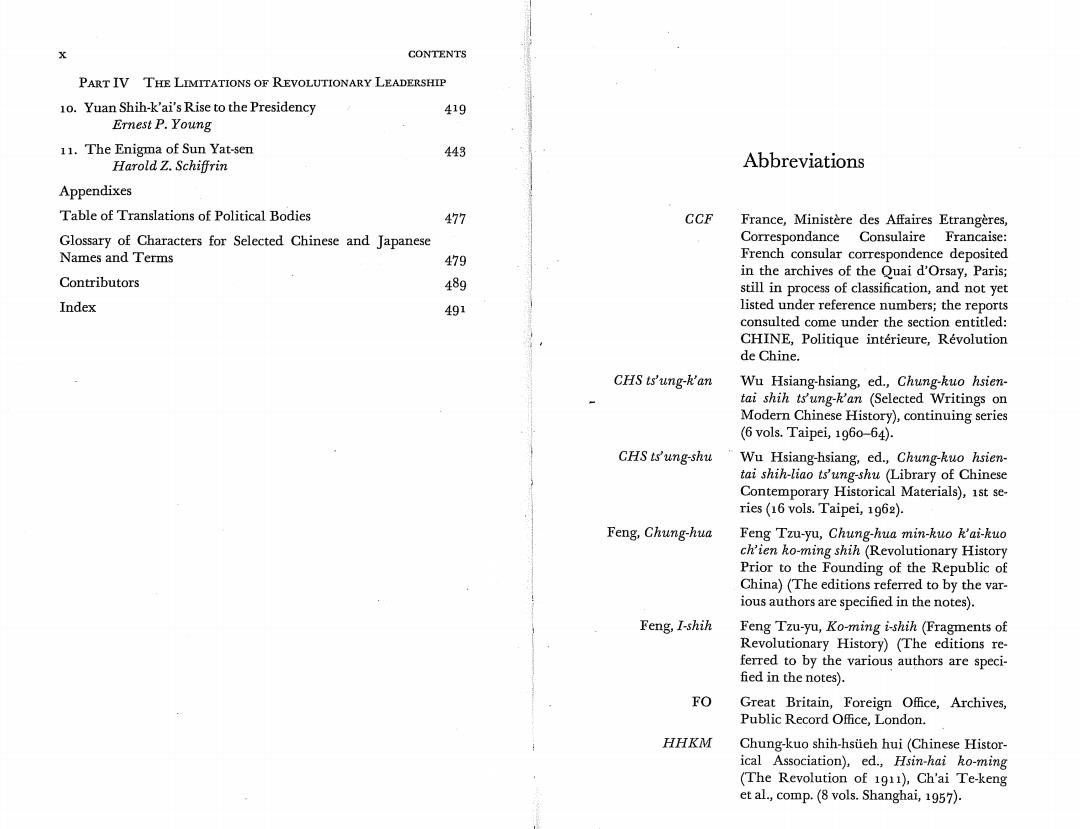
CONTENTS PART IV THE LIMITATIONS OF REVOLUTIONARY LEADERSHIP 10.Yuan Shih-k'ai's Rise to the Presidency 419 Ernest P.Young 11.The Enigma of Sun Yat-sen 443 Harold Z.Schiffrin Abbreviations Appendixes Table of Translations of Political Bodies 477 CCF France,Ministere des Affaires Etrangeres, Glossary of Characters for Selected Chinese and Japanese Correspondance Consulaire Francaise: Names and Terms 479 French consular correspondence deposited in the archives of the Quai d'Orsay,Paris; Contributors 48g still in process of classification,and not yet Index 491 listed under reference numbers;the reports consulted come under the section entitled: CHINE,Politique interieure,Revolution de Chine. CHS ts'ung-k'an Wu Hsiang-hsiang,ed.,Chung-kuo hsien- tai shih ts'ung-k'an (Selected Writings on Modern Chinese History),continuing series (6 vols.Taipei,1960-64). CHS ts'ung-shu Wu Hsiang-hsiang,ed.,Chung-kuo hsien- tai shih-liao ts'ung-shu (Library of Chinese Contemporary Historical Materials),ist se- ries(16 vols.Taipei,1962). Feng,Chung-hua Feng Tzu-yu,Chung-hua min-kuo k'ai-kuo ch'ien ko-ming shih (Revolutionary History Prior to the Founding of the Republic of China)(The editions referred to by the var- ious authors are specified in the notes). Feng,I-shih Feng Tzu-yu,Ko-ming i-shih(Fragments of Revolutionary History)(The editions re- ferred to by the various authors are speci- fied in the notes). FO Great Britain,Foreign Office,Archives, Public Record Office,London. HHKM Chung-kuo shih-hstieh hui(Chinese Histor- ical Association),ed.,Hsin-hai ko-ming (The Revolution of 1911),Ch'ai Te-keng et al.,comp.(8 vols.Shanghai,1957)